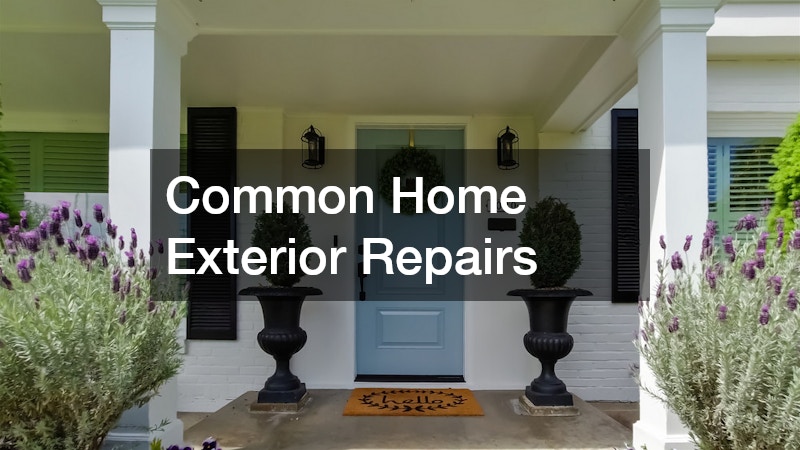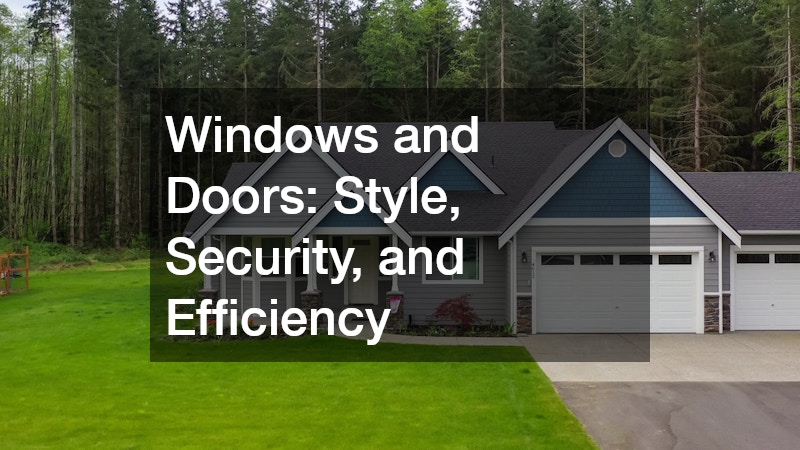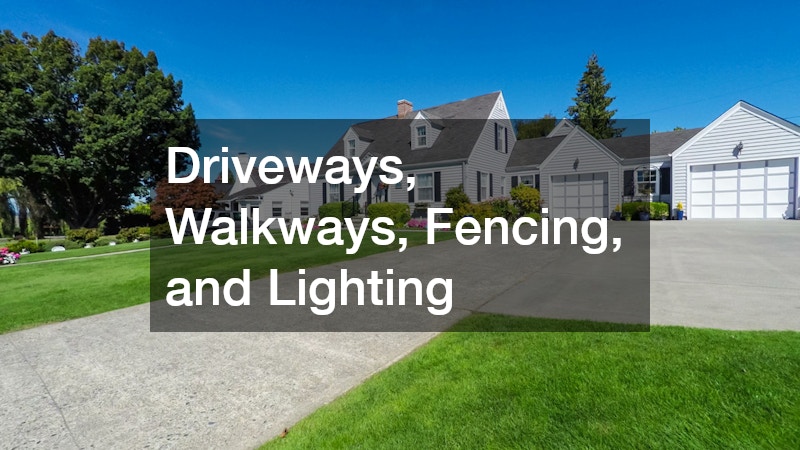The exterior of your home is far more than just a decorative facade—it’s the first impression that visitors, neighbors, and potential buyers experience. A well-maintained exterior communicates care, safety, and value, while neglected features, such as peeling paint, damaged siding, or a sagging garage door, can make even a beautiful home appear unkempt. Prioritizing home exterior repairs is therefore not only about aesthetics; it’s also about protecting your home’s structure, preventing costly damage, and increasing its long-term value.
Maximizing curb appeal involves a careful balance of structural maintenance, functional improvements, and visual enhancements. Repairs like garage door repair, drain cleaning, or well inspections ensure the safety and operational efficiency of your property. At the same time, aesthetic updates, including fresh siding, a repaired shingle roof, or well-placed lighting, create a polished, inviting appearance.
This guide provides homeowners with a step-by-step roadmap to assess, plan, and execute exterior repairs effectively. From determining which projects are most urgent to deciding whether to hire a professional roofer or a local siding company, this resource ensures that every decision contributes to both immediate curb appeal and long-term home value.
Common Home Exterior Repairs

Understanding the most common exterior repairs is the first step toward creating an actionable plan. Not all repairs are equal—some directly affect safety and structural integrity, while others primarily influence appearance. By identifying which areas are most critical, homeowners can prioritize efficiently.
Structural Repairs
Roofing: A sound roof is one of the most crucial aspects of your home’s exterior. Issues like missing, curling, or cracked shingles can lead to leaks, water damage, and mold growth. These problems not only compromise your home’s structural integrity but also significantly reduce curb appeal. A professional roofer or reputable roofing company can help assess whether a repair, patch, or full replacement—such as upgrading to metal roofing—is the best long-term solution.
Siding and Exterior Walls: Damaged or deteriorating siding can affect both the functionality and appearance of your home. Cracks, warping, and rotting boards allow moisture and pests to enter, potentially causing severe structural problems. Hiring local siding companies ensures material matching, proper installation, and a finished look that complements your home’s architectural style.
Garage Doors: The garage door is often one of the largest visual elements on a home’s exterior. Sagging, dented, or malfunctioning doors not only look unsightly but also pose safety risks. A garage door repair can instantly refresh your home’s appearance while ensuring functionality and security.
Drainage Systems: Proper drainage prevents water from pooling around the foundation, which can lead to cracks, erosion, and structural instability. Regular drain cleaning keeps gutters and downspouts clear, protecting both your home and your landscaping investments.
Water Systems: Homes relying on wells and septic systems need regular attention. Well inspections ensure safe, reliable water supply, while hiring septic cleaners prevents overflows or backups that could damage landscaping or soil around the home.
Aesthetic Repairs
While structural repairs protect your home, aesthetic improvements enhance its visual appeal and create a welcoming environment. Some of the most common aesthetic-focused repairs include:
- Painting and Touch-Ups: Peeling paint or faded trim diminishes curb appeal. Fresh paint, carefully chosen to complement the home’s roof, siding, and shutters, revitalizes the exterior.
- Siding Maintenance: Even siding in good condition may benefit from cleaning, repainting, or minor repairs. Power washing and patching cracks restore a uniform, polished look.
- Entryway Enhancements: Updated doors, hardware, or a repaired garage door dramatically improve the visual impression.
- Landscaping Improvements: Well-placed plants, mulch, borders, and walkways highlight structural upgrades and contribute to a cohesive, welcoming appearance.
Seasonal Considerations
Timing repairs according to the season ensures maximum effectiveness and longevity:
- Spring: Ideal for exterior painting, landscaping, and gutter inspections. After winter, damage may be more visible, and the weather is generally cooperative for outdoor projects.
- Summer: Roofing projects, including repairs or replacements, are best scheduled in dry, warm months. Metal roofing installations and siding upgrades also benefit from stable weather.
- Fall: Focus on drain cleaning, roof inspections, and preparing your home for winter weather. Clearing gutters and downspouts prevents ice dams and water damage.
- Winter: In colder climates, exterior projects may be limited. Focus on minor touch-ups, planning future repairs, and inspecting windows, doors, and insulation.
Understanding common home exterior repairs allows homeowners to make informed decisions about where to invest time, money, and energy. Structural repairs like roofing, siding, and garage doors must take priority, while drainage systems and water infrastructure require ongoing maintenance. Once safety and function are ensured, aesthetic improvements—painting, siding touch-ups, landscaping, and lighting—enhance curb appeal and create a lasting first impression.
Strategic seasonal planning ensures each repair is executed effectively, extending the life of your investments and maximizing both safety and beauty. Recognizing which projects are urgent and which can be scheduled later lays the foundation for a comprehensive, actionable exterior maintenance plan.
The exterior of your home is far more than just a decorative facade—it’s the first impression that visitors, neighbors, and potential buyers experience. A well-maintained exterior communicates care, safety, and value, while neglected features, such as peeling paint, damaged siding, or a sagging garage door, can make even a beautiful home appear unkempt. Prioritizing home exterior repairs is therefore not only about aesthetics; it’s also about protecting your home’s structure, preventing costly damage, and increasing its long-term value.
Maximizing curb appeal involves a careful balance of structural maintenance, functional improvements, and visual enhancements. Repairs like garage door repair, drain cleaning, or well inspections ensure the safety and operational efficiency of your property. At the same time, aesthetic updates, including fresh siding, a repaired shingle roof, or well-placed lighting, create a polished, inviting appearance.
This guide provides homeowners with a step-by-step roadmap to assess, plan, and execute exterior repairs effectively. From determining which projects are most urgent to deciding whether to hire a professional roofer or a local siding company, this resource ensures that every decision contributes to both immediate curb appeal and long-term home value.
Windows and Doors: Style, Security, and Efficiency

Windows and doors are more than functional elements—they significantly influence your home’s curb appeal, energy efficiency, and security.
Improving Security and Functionality
- Repair broken locks, hinges, or warped frames to prevent drafts and maintain safety.
- Replace damaged or outdated doors and windows to enhance functionality.
- Ensure proper sealing to prevent air leaks, moisture intrusion, and pest entry.
Stylish Choices for Visual Appeal
- Modern entry doors in bold colors can create a focal point for your home’s facade.
- Garage door repair or replacement can transform the exterior appearance instantly. Choose finishes, textures, and colors that complement your siding and roof.
- Window styles, such as double-hung, casement, or bay windows, add character and dimension.
Energy Efficiency Benefits
- Upgrading to double- or triple-pane windows reduces energy costs by improving insulation.
- Insulated doors and frames prevent heat loss, contributing to overall home comfort.
- Efficient windows and doors increase the resale value of your home, making it more attractive to buyers.
Landscaping: Framing Your Home
Landscaping is a critical component of curb appeal, as it frames the home and draws attention to exterior improvements.
Design Principles and Plant Selection
- Use symmetry and focal points to create a visually balanced layout.
- Layer plants from tall to short to add depth and dimension.
- Incorporate colors that complement your home’s siding, trim, and roofing materials from roofing suppliers.
Sustainable and Low-Maintenance Options
- Drought-resistant or native plants reduce water usage and maintenance needs.
- Mulch and gravel help prevent weeds and enhance visual appeal.
- Consider installing automated irrigation to maintain healthy landscaping without constant effort.
Hardscaping Features and Borders
- Stone or brick walkways, retaining walls, and patios create a polished look.
- Borders for flower beds or pathways add definition and structure.
- Integrated lighting highlights repaired or upgraded elements, such as a new roof or siding.
Driveways, Walkways, Fencing, and Lighting

Driveways and Walkways
- Repair cracks and uneven surfaces to improve safety and appearance.
- Choose materials that complement the exterior: concrete, asphalt, stamped concrete, or pavers.
- Decorative features, like embedded lights or stone borders, enhance visual appeal.
- Proper drain cleaning prevents water pooling and erosion near driveways and walkways.
Fencing and Gates
- Fences provide privacy, security, and style.
- Choose materials based on aesthetics and maintenance needs: wood, metal, or vinyl.
- Ensure gates and hinges are functional and well-maintained.
- Match fencing design with your home’s exterior for a cohesive look.
Exterior Lighting
- Lighting improves safety, security, and curb appeal.
- Highlight entrances, landscaping, and architectural features with warm-toned LED lights.
- Solar and motion-sensor lighting options reduce energy costs.
- Proper placement emphasizes newly repaired or upgraded elements, such as your garage door repair or fresh siding.
Maintenance Timeline: Keeping Repairs on Track
Creating a regular maintenance schedule ensures your home’s exterior stays in top condition.
Monthly
- Inspect gutters and downspouts, clean debris.
- Check lighting and outdoor fixtures.
- Examine windows, doors, and trim for minor damage.
Quarterly
- Trim landscaping, mow lawns, and remove dead plants.
- Inspect driveways, walkways, and fences for cracks or damage.
- Schedule minor touch-ups to siding or paint as needed.
Annually
- Professional roof inspections and shingle roof assessments.
- Well inspections and septic cleaners service.
- Clean and seal driveways and patios.
Every 5–7 Years
- Repaint exterior siding and trim.
- Replace aging roofing or siding materials.
- Upgrade windows, doors, and fences if necessary.
Budgeting and Planning Repairs

Strategic budgeting ensures you address urgent needs while planning long-term upgrades.
- Allocate funds first for safety and structural repairs (roof, siding, garage doors, drainage).
- Factor in aesthetic updates like landscaping, lighting, and painting.
- Obtain multiple quotes from roofing companies, local siding companies, and other contractors to ensure fair pricing.
- Include a contingency for unexpected repairs, especially in older homes.
- Consider energy-efficient upgrades such as metal roofing, insulated windows, and weather-resistant siding for long-term savings.
Prioritizing home exterior repairs requires careful planning and attention to both function and aesthetics. Start with safety and structural needs, such as your shingle roof, garage door repair, siding, and drainage systems. Then focus on visual upgrades: painting, landscaping, lighting, and minor architectural details. Finally, plan long-term enhancements like metal roofing, decorative fencing, and energy-efficient windows.
Hiring experienced professionals, including roofers, roofing companies, local siding companies, well inspectors, and septic cleaners, ensures quality results and peace of mind. By combining strategic prioritization, proper maintenance, and thoughtful aesthetic upgrades, homeowners can maximize curb appeal, protect their investment, and enjoy a home exterior that impresses visitors and stands the test of time.
